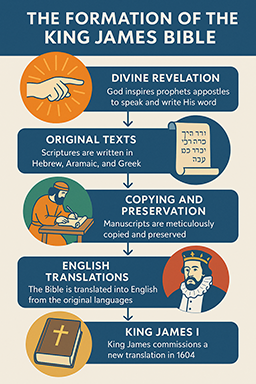Article
Search Articles
Listen
Download Article Study Sheet
Get the study sheet to review the highlights of this article.
Download SummaryRelated Articles
Get The Infographic
Get the full sized infopgraphic overview highlighting the key points discussed in this article.
Download Now
Popular Topics
From Divine Revelation to the King James Bible: The Inspired Journey of Scripture
 Loading author...
Loading author...

The King James Bible of 1611 stands as one of the most influential and revered translations of the Bible in history. For many, it is not just a translation but a monument to the inspired Word of God, faithfully preserved through centuries of divine guidance. The journey from God’s initial revelation to the printed pages of the King James Version (KJV) is a remarkable story of divine inspiration, human diligence, and providential care. Here we trace the comprehensive path of how the Bible went from God’s mouth to the KJV, demonstrating its inspired nature and providing readers with a strong foundation for understanding its origins.
Divine Inspiration: The Origin of Scripture
The story begins with God Himself. The Bible itself claims to be the
inspired Word of God, breathed out by the Holy Spirit. In Timothy 3:16, Paul writes,
“All scripture is given by inspiration of God, and is profitable for doctrine, for
reproof, for correction, for instruction in righteousness.” The Greek word for
“inspiration” here, theopneustos, literally means “God-breathed.” Similarly,
2 Peter 1:21 declares, “For the prophecy came not in old time by the will of
man: but holy men of God spake as they were moved by the Holy Ghost.” From
the outset, the Scriptures were not mere human writings but divine revelations,
delivered through chosen prophets and apostles under the Spirit’s guidance.
God’s revelation unfolded progressively over centuries. To Moses, He
gave the Law on Mount Sinai (Exodus 20). Through prophets like Isaiah and Jeremiah, He spoke
messages of judgment and hope. In the New Testament, Jesus Christ, the Word incarnate (John 1:1),
commissioned His apostles to proclaim the gospel, and their writings, inspired by the Spirit,
completed the canon of Scripture. This divine origin ensures that the Bible is not a collection
of human ideas but God’s authoritative voice to humanity.
The Old Testament: From Oral Tradition to Hebrew Manuscripts
The Old Testament, or Hebrew Scriptures, began with God’s spoken word to figures like Moses,
who recorded the Pentateuch (the first five books) around 1400 BC. These writings were initially preserved orally
and then inscribed on materials like stone, clay, or papyrus. As Israel’s history unfolded, prophets and scribes
meticulously recorded God’s revelations, forming books like Psalms, Isaiah, and Daniel.
By the time of the Babylonian exile (6th century BC), the Hebrew
Scriptures were largely compiled. Scribes, known as Soferim, played a crucial role in
copying and preserving these texts. Their work was governed by strict rules to ensure
accuracy, such as counting letters and checking for errors. The Hebrew text they produced
became the foundation of the Masoretic Text, named after the Masoretes, Jewish scholars who,
from the 6th to 10th centuries AD, standardized the text with vowel points and annotations
to preserve pronunciation and meaning.
The Septuagint (LXX), a Greek translation of the Hebrew Scriptures made around 250–150 BC in Alexandria, also played a role in spreading God’s Word among Greek-speaking Jews and early Christians. While the Septuagint was widely used, the Hebrew Masoretic Text remained the authoritative text for Jewish and later Christian scholars. The discovery of the Dead Sea Scrolls (2nd century BC–1st century AD) confirms the remarkable accuracy of the Masoretic tradition, as these ancient manuscripts closely align with later Masoretic copies.
The New Testament: From Apostolic Writings to Greek Manuscripts
The New Testament emerged in the 1st century AD, as the apostles
and their associates recorded the life, teachings, and work of Jesus Christ. The Gospels,
epistles, and Revelation were written in Greek, the common language of the Roman Empire,
on papyrus scrolls or codices. These original documents, called autographs, were inspired
and inerrant, but they did not survive due to the perishable nature of papyrus.
However, the early church rapidly copied and circulated these writings. By the
2nd century, thousands of Greek manuscripts existed, preserved by churches across the Mediterranean.
These manuscripts fall into two main text types: the Byzantine (or Majority Text), which dominated in
the Greek-speaking East, and the Alexandrian, found in Egypt. The Byzantine manuscripts, numbering in
the thousands, formed the basis for later translations, including the KJV.
Despite challenges like persecution and the fragility of materials, the New Testament was
preserved with astonishing fidelity. By the 4th century, the canon of the New Testament
was widely recognized, formalized by councils like Hippo (393 AD) and Carthage (397 AD), though these councils merely
affirmed what the church already accepted.
The Role of Early Translations
As Christianity spread, Scripture was translated into various languages.
Jerome's Latin Vulgate (late 4th century), commissioned by Pope Damasus I, became the standard for
the Western Church. Jerome translated from Hebrew and Greek, but also consulted the Septuagint and
Old Latin texts. Though influential, the Vulgate included some interpretive choices based on the
manuscripts available to Jerome.
Other early translations included the Syriac Peshitta and Coptic versions. These regional
translations preserved Scripture in diverse linguistic and cultural contexts but were ultimately secondary to the
Hebrew and Greek originals for textual accuracy.
The Middle Ages: Preservation Amid Challenges
During the Middle Ages, the Bible was preserved primarily through handwritten
manuscripts. In the East, Greek Orthodox churches continued copying Byzantine manuscripts, while in
the West, Latin manuscripts of the Vulgate dominated. Monastic scribes labored in scriptoria, copying
texts with painstaking care. Despite errors that crept into some copies (e.g., misspellings or omissions),
the sheer number of manuscripts—over 5,000 for the New Testament alone—ensured that no essential doctrine was lost.
The invention of the printing press by Johannes Gutenberg in 1455 revolutionized Bible production.
Gutenberg’s first major work was a printed Latin Vulgate Bible, making Scripture more accessible. However, the Reformation’s
emphasis on returning to original languages shifted focus back to Hebrew and Greek texts.
The Reformation and the Textus Receptus
The 16th century marked a turning point. The Protestant Reformation, led by
figures like Martin Luther, emphasized sola scriptura (Scripture alone) and the need for translations
based on original languages. Scholars like Erasmus of Rotterdam sought to recover the Greek New Testament.
In 1516, Erasmus published the first printed Greek New Testament, compiling it from several Byzantine
manuscripts. His work, though rushed and based on a handful of late manuscripts, laid the groundwork
for later editions.
Subsequent scholars, like Robert Stephanus and Theodore Beza, refined Erasmus’s text,
producing editions that became known as the Textus Receptus (Received Text). The term, coined in a 1633 edition,
reflected the belief that this text, based on the majority of Byzantine manuscripts, was providentially preserved.
The Textus Receptus became the standard Greek text for Protestant translations, including the KJV.
For the Old Testament, the Masoretic Text, particularly the Bomberg edition of
1516–1517, provided a reliable Hebrew source. The Reformation’s commitment to original languages ensured
that translations like Luther’s German Bible and Tyndale’s English Bible prioritized Hebrew and Greek
over the Vulgate.
The Path to the King James Bible
The English Bible tradition began with John Wycliffe’s translation in the 1380s,
based on the Vulgate. William Tyndale’s work in the 1520s–1530s was a milestone, as he translated directly
from Hebrew and Greek, producing a New Testament and portions of the Old Testament. Tyndale’s vivid, accessible
style influenced all later English Bibles, though he was martyred before completing his work.
(He was convicted of heresy for translating the Bible into English and was strangled and then burned at the
stake in 1536 near Brussels. )
Subsequent English translations, like the Coverdale Bible (1535), Matthew’s Bible (1537),
and the Geneva Bible (1560), built on Tyndale’s foundation. The Geneva Bible, produced by English exiles in Switzerland,
was especially popular but included Calvinist notes that King James I found objectionable. The Bishops’ Bible (1568),
commissioned by the Church of England, aimed to replace the Geneva but lacked its readability.
In 1604, King James I convened the Hampton Court Conference to address religious tensions. Puritan leaders
proposed a new Bible translation to unify the church. James, eager to replace the Geneva Bible, approved the project.
The translation was to be based on the best Hebrew and Greek texts, free of partisan notes, and designed for public reading.
The Making of the King James Bible
The KJV was a collaborative effort of 47 scholars, divided into six companies working
in Oxford, Cambridge, and Westminster. These men, among the finest linguists and theologians
of their day, were instructed to:
• Use the Bishops’ Bible as a base but revise it based on Hebrew and Greek.
• Consult earlier English translations (e.g., Tyndale, Geneva) and other versions (e.g., Vulgate, Septuagint) for clarity.
• Preserve ecclesiastical terms and ensure the translation was suitable for worship.
For the Old Testament, the translators relied on the Masoretic Text, using the Bomberg
edition and consulting Aramaic Targums and the Septuagint for difficult passages. For the New Testament,
they used the Textus Receptus, primarily Beza’s 1598 edition, cross-referencing earlier editions by Erasmus
and Stephanus. The Vulgate was consulted but not prioritized, as the translators’ Protestant convictions
emphasized original languages.
The translation process was rigorous. Each company translated assigned portions,
reviewed them internally, and submitted them to a general committee for final approval. The translators
aimed for accuracy and elegance, producing a text that was both faithful to the originals and resonant
in English. Their preface to the KJV acknowledges their reliance on God’s providence and the labor of
prior translators.
The Inspiration of the King James Bible
The KJV’s inspiration lies in its fidelity to the inspired autographs, preserved through God’s
providential care. While only the original autographs were inerrant, the abundance of manuscripts—over 5,000 for
the New Testament and numerous Hebrew copies—ensures that the text underlying the KJV is overwhelmingly reliable.
The Byzantine manuscripts, which form the Textus Receptus, represent the majority of Greek texts and were used by
the church for centuries, suggesting divine preservation.
The KJV’s translators believed they were handling God’s Word. Their meticulous process, guided by
prayer and scholarship, produced a translation that captures the theological and literary depth of the originals. Passages
like Psalm 23, John 3:16, and Romans 8:28 in the KJV resonate with a majesty that has shaped English literature and Christian
worship for centuries.
Critics argue that the KJV, based on late manuscripts, includes minor additions (e.g., the Comma
Johanneum in 1 John 5:7-8). However, these do not alter core doctrines, and the vast agreement among manuscripts supports
the text’s integrity. The KJV’s enduring impact—its use in revivals, missions, and theology—further attests to its role
as a faithful conduit of God’s Word.
In The End
The journey from Divine Revelation to the King James Bible of 1611 is a testament to
divine inspiration and human stewardship. From the God-breathed autographs to the Hebrew Masoretic Text
and Greek Textus Receptus, the Scriptures were preserved through centuries of copying, translation,
and scholarship. The KJV, built on the labors of Tyndale, the Reformers, and 47 dedicated scholars,
stands as a faithful translation of God’s Word, rooted in the best manuscripts of its time.
Its accuracy, beauty, and impact affirm its inspired status, offering readers
a reliable foundation for faith and practice. As Psalm 12:6-7 declares, “The words of the Lord are pure
words: as silver tried in a furnace of earth, purified seven times. Thou shalt keep them, O Lord, thou
shalt preserve them from this generation for ever.” The King James Bible, through God’s providence,
fulfills this promise, delivering His Word to generations past and present.
Tags: